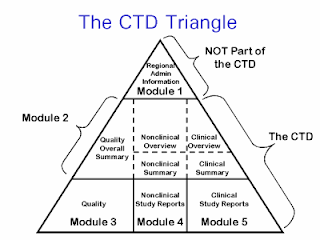Common Technical Documents or CTDs are critical sets of information of a new drug that comprise the application dossier. The application dossier is then submitted for the purpose of obtaining approval by regional regulatory authorities before the drug can undergo clinical trials and subsequently be introduced in the market. These regional regulatory organizations include the Food and Drug Administration, or the FDA for the United States of America, the European Medicines Agency, or the EMA for Europe, and the Ministry of Health, Labour, and Welfare for Japan.
 Each CTD is segmented into five modules:
Each CTD is segmented into five modules:
1. Administrative and prescribing information
2. Overview and summary of pharmaceutical drugs
3. Quality (pharmaceutical documentation)
4. Pre-clinical (Pharmacology/Toxicology)
5. Clinical (Efficacy and Safety)
Module 1
Each of these modules contain subheadings that are standardized for all jurisdictions of regulation by the respective regulatory organisations, although the information contained in the first module, is specific to the federal requirements of each of the organizations, and contains information pertaining to the application forms and the proposal on the labeling of the drug in question. Apart from the US, Europe, and Japan, Canada and Switzerland have also come to adopt the CTD format. Today, the CTD format remains the most preferred format in the preparation of application dossiers for new drug applications for the FDA, EMA, and the Ministry of Health, Labour, and Welfare in Japan.
Module 2 of the CTDs includes summaries containing an overview of the pharmaceutical drug, and how the drug works. This can refer to the pharmacological category the drug belongs to, how it can take effect in the body, and what is the recommended clinical use of the drug. Hence, Module 2 will comprise of information that speaks of the quality of the drug, both clinically and non-clinically.
Related: Abbreviated New Drug Application (ANDA)
Module 3
Module 3 of the CTDs is dedicated to elaborating on the quality control aspects of developing and testing the drug, namely in the chemistry, manufacturing, and controls of the formulating the drug. Module 3 of the registration dossier will contain this information in the same sequence and will be uniformly presented with a table of contents, indicating subheadings on Drug Substance, and Drug Product. There will also be various other appendices on specific aspects of the drug, such as the synthesis of the drug substance, manufacture of the drug product, and container closure.
Module 4 and Module 5 both contain reports, but of non-clinical and clinical studies respectively. The non-clinical study reports in Module 4 are prepared based on the meticulous evaluation of the proposed drug's pharmacologic, pharmacokinetic, and toxicological effects, and are presented and discussed very extensively. Module 5 on the other hand, contains the raw data of the clinical study reports on the efficacy of the drug in length, with a particular focus on the benefit-risk aspect of the drug.
 Each CTD is segmented into five modules:
Each CTD is segmented into five modules:1. Administrative and prescribing information
2. Overview and summary of pharmaceutical drugs
3. Quality (pharmaceutical documentation)
4. Pre-clinical (Pharmacology/Toxicology)
5. Clinical (Efficacy and Safety)
Module 1
Each of these modules contain subheadings that are standardized for all jurisdictions of regulation by the respective regulatory organisations, although the information contained in the first module, is specific to the federal requirements of each of the organizations, and contains information pertaining to the application forms and the proposal on the labeling of the drug in question. Apart from the US, Europe, and Japan, Canada and Switzerland have also come to adopt the CTD format. Today, the CTD format remains the most preferred format in the preparation of application dossiers for new drug applications for the FDA, EMA, and the Ministry of Health, Labour, and Welfare in Japan.
Module 2 of the CTDs includes summaries containing an overview of the pharmaceutical drug, and how the drug works. This can refer to the pharmacological category the drug belongs to, how it can take effect in the body, and what is the recommended clinical use of the drug. Hence, Module 2 will comprise of information that speaks of the quality of the drug, both clinically and non-clinically.
Related: Abbreviated New Drug Application (ANDA)
Module 3
Module 3 of the CTDs is dedicated to elaborating on the quality control aspects of developing and testing the drug, namely in the chemistry, manufacturing, and controls of the formulating the drug. Module 3 of the registration dossier will contain this information in the same sequence and will be uniformly presented with a table of contents, indicating subheadings on Drug Substance, and Drug Product. There will also be various other appendices on specific aspects of the drug, such as the synthesis of the drug substance, manufacture of the drug product, and container closure.
Module 4 and Module 5 both contain reports, but of non-clinical and clinical studies respectively. The non-clinical study reports in Module 4 are prepared based on the meticulous evaluation of the proposed drug's pharmacologic, pharmacokinetic, and toxicological effects, and are presented and discussed very extensively. Module 5 on the other hand, contains the raw data of the clinical study reports on the efficacy of the drug in length, with a particular focus on the benefit-risk aspect of the drug.

No comments:
Post a Comment
Please don't spam. Comments having links would not be published.